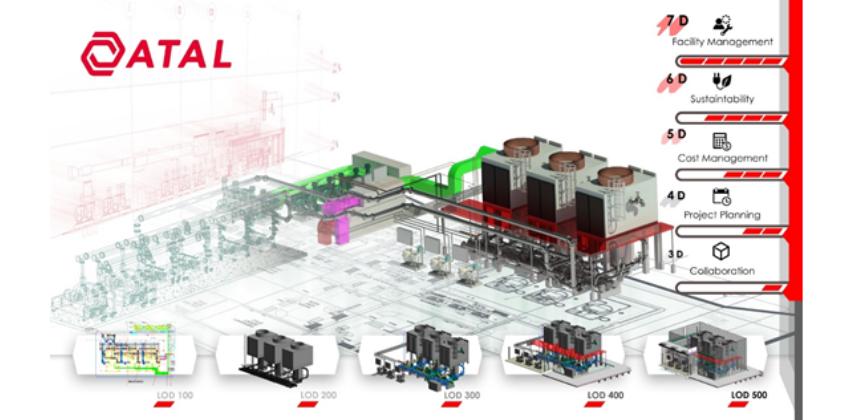Trendy adoption of BIM in Hong Kong market
Building Information Modelling (BIM) is the computational technology which digitalises construction process in the form of 3D models to 5D1 models, enabling industry practitioners to visualise the building progress easily. BIM journey originally started in the UK with initial adoption of PAS1192 and finally to ISO 19650, an internationally recognised BIM standard with proven track record worldwide.
Recently, with strong support from the Development Bureau of the HKSAR Government and Construction Industry Council (CIC), our industry practitioners have been driving the transformation in full speed. For instance, the Modular Integrated Construction (MiC) methodology, which is one of the most common applications of BIM, has already caught the public’s attention. At the sametime, other opportunities in Design for Manufacture and Assembly (DfMA) for all construction disciplines are intensively explored. Under the leadership of CIC, a DfMA alliance from different stakeholders in the construction field has been recently established. Not surprisingly, BIM is regarded as a possible sustainable solution for our industry to Construction 2.0 Era 2.
Building services engineering in DfMA and MiC
DfMA (for construction application) refers to the design approach that focuses on the ease of manufacture and efficiency of assembly which generally covers all production of building elements, in the form of modules or system components. Over the years, DfMA concept has been applied in many structural elements such as concrete works of road segments, building façade wall, etc. Recently, DfMA has been successfully adopted in Modular Integrated Construction, in which even the general public familiarise with MiC too. The most updated and notable examples include the construction of massive modular quarantine wards for COVID-19 pandemic, as well as some pilot MiC projects which will be completed by 2022. BIM technologies embark a new approach for our building services sector. Elements such as prefabricated plumbing modules, M&E installation integrated with architectural fitting out works, etc, also took important part in those MiC projects, in analogy with a human body with its organs nerve fibers and blood vessel connection in a transplantation surgery.
Other than the MiC approach, the industry also explores widely the opportunities in offsite modular prefabrication works for Mechanical, Electrical and Plumbing (MEP) application, particularly on simplifying & systemising design of a MEP module. It is possible to manufacture and assemble system components more efficiently, with minimum time and lower cost. In the past, without BIM application, analysis of MEP modules in 3D CAD drawings or real modelling is costly and time consuming. Nowadays, BIM technologies facilitate our 3D analysis simply in the digital virtual environment. Lower cost in 3D printing further encourages industry practitioners at all levels to take part during the coordination progress.
Digital Twin & Facility Management (FM)
BIM application is not only confined within the construction stage. It is not merely for generating 3D construction drawings. BIM is just more than that. When using BIM technologies, a Digital Twin environment is created simultaneously too.
“Digital Twin” refers to any real physical construction items that repeat their properties (such as project geometrical data, construction activities, operation data etc) in the virtual digital environment. For instance, builders and building services engineers can easily coordinate and perform targeted activities in digital environment in advance, overviewing construction sequences, safety, services conflicts, etc and aiming at solutions in earlier construction stage. Whilst for facility and asset management aspects, building services engineers can evaluate and optimise the building performance, exploring green opportunities for system best settings to suit its operation needs and maintain its best asset values.
Approach to Digital Twin triggers an ultimate form of an Asset Information Model (AIM), as defined in ISO 19650, in the BIM environment. The AIM records useful system data from construction stage to the operation conditions in Common Data Environment (CDE), which suits its asset management purpose and organisational business goal. In other words, not only the BIM 3D model is included in CDE, but also other data such as O&M manuals, operation data in Building Management System (BMS) and the service track log can be found. It certainly simplifies daily FM operation and allows preventive approach of FM maintenance possible.
Future of building services engineering with BIM technology
BIM is a continuous process to contribute a real intelligent and sustainable building life cycle, in which building services engineers play a vital role to connect the real physical building to the virtual CDE. After all, data related to building services will be well categorised and identified in BIM library. The whole work process is a cradle-to-cradle approach.
The ongoing trend is promising, only if all of us have a strong belief - to innovate and embrace such revolutionary changes. The transition period from manual drawings to wide adoption of CAD drawings just happened in 10 years. Whilst everyone only talked about onsite production for air ductworks 20+ years ago, nowadays all of us agree that offsite prefabrication is the only way. Similarly, BIM-based DfMA is a viable solution to the difficulties our building services industry is facing now: ageing workers, less new skillful labour, as well as safety and site constraints.
Just embrace our Construction 2.0 evolution in building services engineering with BIM!
1 5D BIM models include 3D building model, plus time & sequence factor (4D) to cost & quantity take-off aspects (5D)
2 HKSAR Government has developed Construction 2.0 in Oct 2018 to strengthen and maintain Hong Kong’s established regional leadership position in construction, whilst enhancing the Industry’s sustainability and long-term growth prospects
By Ir Brian W L CHENG from the Building Services Division of the HKIE



